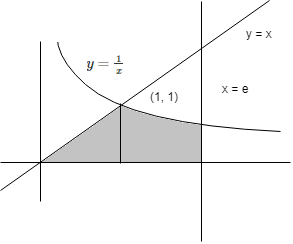CBSE Test Paper 01
Chapter 8 Application of Integrals
The area bounded by the curves y2=20x and x2=16y is equal to
- 3203 sq. units
- 80π sq. units
- none of these
- 100π sq. units
The area of the region bounded by the parabola ( y - 2)2 = x - 1, the tangent to the parabola at the point ( 2 , 3 ) and the x – axis is equal to
- none of these
- 6 sq. units
- 9 sq. units
- 12 sq. units
The area bounded by the curves y=x−−√, 2y + 3 = xand the x – axis in the first quadrant is
- 36
- 18
- 9
- none of these
If the area cut off from a parabola by any double ordinate is k times the corresponding rectangle contained by that double ordinate and its distance from the vertex, then k is equal to
- 23
- 3
- 13
- 32
The area bounded by the curves y = cos x and y = sin x between the ordinates x = 0 and x=π2is equal to
- 2(2–√+1) sq. units
- 2(2–√−1) sq. units
- (42–√−1) sq. units
- (42–√+1) sq. units
The area of the bounded by the lines y = 2, x = 1, x = a and the curve y = f(x), which cuts the last two lines above the first line for all a≥1, is equal to 23[(2a)3/2−3a+3−22–√]. Find f(x)
Let f(x) be a continuous function such that the area bounded by the curve y=f(x), x-axis and the lines x=0 and x=a is a22+a2sin a+π2 cos a, then find f(π2).
Find the area of the region enclosed by the curves y = x , x = e, y = 1x and the positive x-axis.
Calculate the area of the region enclosed between the circles: x2 + y2 = 16 and (x + 4)2 + y2 = 16.
Using integration, find the area of region bounded by the triangle whose vertices are (-1, 0), (1, 3) and (3, 2).
Find the area of the region {(x,y);x2⩽y⩽x}.
Evaluate limx→∞(xxx!)1/x.
Evaluate limx→∞[1x+x2(x+1)3+x2(x+2)3+.........+18x].
Find the area of the region enclosed by the parabola x2= y and the line y=x + 2.
Using integration, find the area of the region enclosed between the two circles x2 + y2 = 4 and (x - 2)2 + y2 = 4.
CBSE Test Paper 01
Chapter 8 Application of Integrals
Solution
- (a) 3203 sq. units
Explanation: Eliminating y, we get: x4=256×20x
⇒x=0,x=8(10)13
Required area:
=∫08(10)13(20x−−−√−x216)dx
=6403−3203=3203 sq units - (c) 9 sq. units
Explanation: Given parabola is: (y−2)2=x−1⇒dydx=12(y−2)
When y= 3, x= 2
∴dydx=12
Therefore, tangent at ( 2, 3 ) is y – 3 = ½ ( x – 2 ). i.e. x – 2y +4 = 0 . therefore required area is: ∫03(y−2)2+1.dy−∫03(2y−4)dy=[(y−2)33+y]30−[y2−4y]30=9 - (c) 9
Explanation: Required area: ∫09x−−√dx−∫39(x−32)dx=[x323/2]90−12[x22−3x]93=9sq.units - (a) 23
Explanation: Required area: 2∫0a4ax−−−√dx
=kα(24aα−−−√)
=8a√3α32
=4a−−√kα32⇒k=23 - (b) 2(2–√−1)sq. units
Explanation: Required area = ∫0π2|sinx−cosx|dx
=∫0π4(cosx−sinx)dx+∫π4π2(sinx−cosx)dx
=[sinx+cosx]π40+[−cosx−sinx]π2π4
=12√+12√−(0+1)−{1−(12√+12√)}
=42√−2=22–√−2=2(2–√−1) - we are given,
∫1a[f(x)−2]dx=23[(2a)3/2−3a+3−22–√]
Differentiating w.r.t a, we get
f(a) - 2 =23[322a−−√.2−3]
f(a)= 22a−−√,a≥1
∴ f(x)=22x−−√,x≥1 - we have, ∫a0f(x)dx=a22+a2sin a+π2cos a
Differentiating w.r.t a,we get,
f(a)=a+ 12(sin a+acos a)−π2sin a
put a=π2, f(π2)=π2+12−π2=12 - We have y=4x2 and y=19x2

Required area =2∫20(3y√−y√2)dy
=2(5y2y√3/2)20
=2.5322–√=202√3 
x2 + y2 = 16
(x + 4)2 + y2 = 16
Intersecting at x = -2
Area=4∫−2−416−x2−−−−−−√dx
=4[∫−2−442−x2−−−−−−√dx] =4[x21−x2−−−−−√+422sin−1x4]−2−4 =4[(−23–√−4π3)−(−4π)]
=(−83–√+32π3)
A (-1, 0) B (1, 3) C (3, 2)
Equation of AB
y−y1=y2−y1x2−x1(x−x1)
y−0=3−01+1(x+1)
y=32(x+1)
Similarly,
Equation of BC y=−12(x−7)
Equation of AC =12(x+1)
Area ΔABC=∫1−132(x+1)dx+∫3112(x−7)dx −∫3−112(x+1)dx
=32[x22+x]1−1+12[7x−x22]31−[x22+x]3−1
=32[(12+1)−(12−1)]+12[(21−92)−(7−12]
−12[(92+3)−(12−1)]
=32(2)+12(10)−12(8)=3+5−4
= 4 sq. units- y = x2

y = x
⇒ x = 0, y = 0
x = 1, y = 1
Area =∫10xdx−∫10x2dx
=∫10(x−x2)dx
=[x22−x33]10
=12−13
=16 sq. units - Given L=limx→∞(xxx!)1/x
Taking logarithm on both sides
log L=limx→∞1x(logx1+logx2+.....+logxx)
= limx→∞1x∑xr=1log xr
=limx→∞1x∑xr=1log 1(r/x)
=∫10log1x dx
=−∫10log x dx
=−[xlog x+x]10
=−[(1log 1+1)−(0log0−0)] = 1
∴ Log L=1
⇒L=e
⇒limx→∞(xxx!)1/x=e - Given, limx→∞[1x+x2(x+1)3+x2(x+2)3+.........+18x]
=limx→∞∑xr=0x2(x+r)3
=limx→∞∑xr=01/x(1+r/x)2
=∫10dy(1+y)3, replace rx by y and 1x by dy
=[−12(1+y)2]10
=[−12(1+12)−−12(1+02)]
=[−12(2)−−12(1)]
=[−14−−12] =14 - We have, x2 = y and y = x + 2
⇒x2=x+2
⇒x2−x−2=0
⇒x2−2x+x−2=0
⇒x(x−2)+1(x−2)=0
⇒(x+1)(x−2)=0
⇒x=−1,2

∴ Required area of shaded region, =∫2−1(x+2−x2)dx=[x22+2x−x33]2−1
=(8−3−12)=92 - Given circles are x2+y2=4...(i)
(x−2)2+y2=4...(ii)
Eq. (i) is a circle with centre origin and
Radius = 2.
Eq. (ii) is a circle with centre C (2, 0) and
Radius = 2.
On solving Eqs. (i) and (ii), we get
(x−2)2+y2=x2+y2
⇒x2 - 4x+4+y2=x2+y2
⇒x=1
On putting x = 1 in Eq. (i), we get
y=±3–√
Thus, the points of intersection of the given circles are A (1, 3–√) and A'(1,-3–√).

Clearly, required area= Area of the enclosed region OACA'O between circles
= 2 [ Area of the region ODCAO]
=2 [Area of the region ODAO + Area of the region DCAD]
=2[∫10y2dx+∫21y1dx]
=2[∫104−(x−2)2−−−−−−−−−−√dx+∫214−x2−−−−−√dx]
=2[12(x−2)4−(x−2)2−−−−−−−−−−√+12×4sin−1(x−22)]10+2[12x4−x2−−−−−√+12×4sin−1x2]21
=[(x−2)4−(x−2)2−−−−−−−−−−√+4sin−1(x−22)]10+[x4−x2−−−−−√+4sin−1x2]21
=[{−3–√+4sin−1(−12)}−0−4sin−1(−1)]+[0+4sin−11−3–√−4sin−112]
=[(−3–√−4×π6)+4×π2]+[4×π2−3–√−4×π6]
=(−3–√−2π3+2π)+(2π−3–√−2π3)
=8π3−23–√ sq units.





